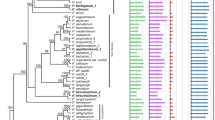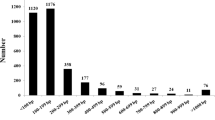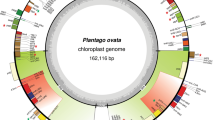Abstract
The endpoints of the large inverted repeat (IR) of chloroplast DNA in flowering plants differ by small amounts between species. To quantify the extent of this movement and define a possible mechanism for IR expansion, DNA sequences across the IR—large single-copy (IR-LSC) junctions were compared among 13Nicotiana species and other dicots. In mostNicotiana species the IR terminates just upstream of, or somewhere within, the 5′ portion of therps19 gene. The truncated copy of this gene,rps19′, varies in length even between closely related species but is of constant size within a single species. InNicotiana, six differentrps19′ structures were found. A phylogenetic tree ofNicotiana species based on restriction site data shows that the IR has both expanded and contracted during the evolution of this genus. Gene conversion is proposed to account for these small and apparently random IR expansions. A large IR expansion of over 12 kb has occurred inNicotiana acuminata. The new IR-LSC junction in this species lies within intron 1 of theclpP gene. This rearrangement occurred via a double-strand DNA break and recombination between poly (A) tracts inclpP intron 1 and upstream ofrps19. Nicotiana acuminata chloroplast DNA contains a ‘molecular fossil’ of the IR-LSC junction that existed prior to this dramatic rearrangement.
Similar content being viewed by others
References
Aldrich J, Cherney BW, Williams C, Merlin E (1988) Sequence analysis of the junction of the large single copy region and the large inverted repeat in the petunia chloroplast genome. Curr Genet 14:487–492
Ambrosini M, Ceci LR, Fiorella S, Gallerani R (1992) Comparison of regions coding for tRNA(His) genes of mitochondrial and chloroplast DNA in sunflower: a proposal concerning the classification of ‘CP-like’ tRNA genes. Plant Mol Biol 20:1–4
Birky CW, Walsh JB (1992) Biased gene conversion, copy number and apparent mutation rate differences within chloroplast and bacterial genomes. Genetics 130:677–683
Bömmer D, Haberhausen G, Zetsche K (1993) A large deletion in the plastid DNA of the holoparasitic flowering plantCuscuta reflexa concerning two ribosomal proteins (rpl2, rpl23), one transfer RNA (trnI) and an ORF2280 homologue. Curr Genet 24:171–176
Boudreau E, Turmel M (1995) Gene rearrangements in Chlamydomonas chloroplast DNAs are accounted for by inversions and by the expansion/contraction of the inverted repeat. Plant Mol Biol 27:351–364
Bowman CM, Dyer TA (1986) The location and possible evolutionary significance of small dispersed repeats in wheat ctDNA. Curr Genet 10:931–941
Bowman CM, Barker RF, Dyer TA (1988) In wheat ctDNA, segments of ribosomal protein genes are dispersed repeats, probably conserved by nonreciprocal recombination. Curr Genet 14:127–136
Cerutti H, Osman M, Grandoni P, Jagendorf AT (1992) A homolog ofEscherichia coli RecA protein in plastids of higher plants. Proc atl Acad Sci USA 89:8068–8072
Cerutti H, Ibrahim Z, Jagendorf AT (1993) Treatment of pea (Pisum sativum L.) with DNA-damaging agents induces a 39-kilodalton chloroplast protein immunologically related toEscherichia coli RecA. Plant Physiol 102:155–163
Cerutti H, Johnson AM, Boynton JE, Gillham NW (1995) Inhibition of chloroplast DNA recombination and repair by dominant negative mutants ofEscherichia coli RecA. Mol Cell Biol 15:3003–3011
Clausen RE, Goodspeed TH (1925) Interspecific hybridisation inNicotiana II. A tetraploidglutinosa-tabacum hybrid, an experimental verification of Winge's hypothesis. Genetics 10:278–284
Delp G, Kössel H (1991) rRNAs and rRNA genes of plastids. In: Bogorad L, Vasil IK (eds) The molecular biology of plastids, Cell culture and somatic cell genetics of plants (vol 7A). Academic Press, San Diego, pp 139–167
Downie SR, Palmer JD (1992) Use of chloroplast DNA rearrangements in reconstructing plant phylogeny. In: Soltis PS, Soltis DE, Doyle JJ (eds) Molecular systematics of plants. Chapman and Hall, New York, pp 14–35
Doyle JJ, Doyle JL (1987) A rapid isolation procedure for small quantities of fresh leaf tissue. Phytochem Bull 19:11–15
Dunigan DD, Golemboski DB, Zaitlin M (1987) Plant resistance to viruses. Ciba Foundation Symposia 133:120–135. Wiley, Chicester
Fleischmann RD, Adams MD, White O, Clayton RA, Kirkness EF, Kerlavage AR, Bult CJ, Tomb JF, Dougherty BA, Merrick JM, McKenney K, Sutton G, FitzHugh W, Fields CA, Gocayne JD, Scott JD, Shirley R, Liu LI, Gloderk A, Kelley JM, Weidman JF, Phillips CA, Spriggs T, Hedblom E, Cotton MD, Utterback TR, Hanna MC, Nguyen DT, Saudek DM, Brandon RC, Fine LD, Fritchman JL, Fuhrmann JL, Geoghagen NSM, Gnehm CL, McDonald LA, Small KV, Fraser CM, Smith HO, Venter JC (1995) Whole-genome random sequencing and assembly ofHaemophilus influenzae Rd. Science 269:496–512
Gray JC, Kung SD, Wildman SG (1974) Origin ofNicotiana tabacum L. detected by polypeptide composition of Fraction I protein. Nature 252:226–227
Goodspeed TH (1954) The genus Nicotiana: origins, relationships and evolution of its species in the light of their distribution, morphology and cytogenetics. Chronica Botanica Company
Guidet F (1994) A powerful new technique to quickly prepare hundreds of plant extracts for PCR and RAPD analyses. Nucleic Acids Res 22:1772–1773
Hallick RB, Hong L, Drager RG, Favreau MR, Monfort A, Orsat B, Spielmann A, Stutz E (1993) Complete sequence ofEuglena gracilis chloroplast DNA. Nucleic Acids Res 21:3537–3544
Harris EH, Boynton JE, Gillham NW (1994) Chloroplast ribosomes and protein synthesis. Microbiol Rev 58:700–754
Herdenberger F, Pillay DTN, Steinmetz A (1990) Sequence of thetrnH gene and the inverted repeat structure deletion site of the broad bean chloroplast genome. Nucleic Acids Res 18:1287
Hiratsuka J, Shimada H, Whittier R, Ishibashi T, Sakamoto M, Mori M, Kondo C, Honji Y, Sun CR, Meng BY, Li YQ, Kanno A, Nishizawa Y, Hirai A, Shinozaki K, Sugiura M (1989) The complete nucleotide sequence of rice (Oryza sativa) chloroplast genome: intermolecular recombination between distinct tRNA genes accounts for a major plastid DNA inversion during the evolution of the cereals. Mol Gen Genet 217:185–194
Höfte H, Desprez T, Amelsem J, Chiapello H, Caboche M, Miosan A, Juorjon MF, Charpenteau JL, Berthomieu P, Guerrier D, Giraudat J, Quigley F, Thomas F, Yu DY, Mache R, Raynal M, Cooke R, Grellet F, Delseny M, Parmentier Y, Marcillac G, Gigot C, Fleck J, Phillips G, Axelos M, Bardet C, Tremousatgue D, Lescure B (1993) An inventory of 1152 expressed sequence tags obtained by partial sequencing of cDNAs fromArabidopsis thaliana. Plant J 4:1051–1061
Holmes FO (1938) Inheritance of resistance to tobacco-mosaic virus in tobacco. Phytopathol 28:553–561
Hoot SB, Palmer JD (1984) Structural rearrangements, including parallel inversions, within the chloroplast genome ofAnemone and related genera. J Mol Evol 38:274–281
Kim YD, Jansen RK (1994) Characterization and phylogenetic distribution of chloroplast DNA rearrangement in the Berberidaceae. Plant Syst Evol 193:107–114
Kowalczykowski SC, Eggleston AK (1994) Homologous pairing and DNA strand exchange proteins. Annu Rev Biochem 63:991–1043
Liere K, Kestermann M, Müller U, Link G (1995) Identification and characterisation of theArabidopsis thaliana chloroplast DNA region containing the genespsbA, trnH andrps19′. Curr Genet 28:128–130
Maier RM, Döry I, Kössel H (1990) ThendhH genes of graminean plastomes are linked with the junctions between small single copy and inverted repeat regions. Curr Genet 18:245–250
Morton BR, Clegg MT (1993) A chloroplast DNA mutational hotspot and gene conversion in a noncoding region nearrbcL in the grass family (Poaceae). Curr Genet 24:357–365
Murphy G, Kavanagh T (1988) Speeding-up the sequencing of double-stranded DNA. Nucleic Acids Res 16:5198
Newman T, de Bruijn FJ, Green P, Keegstra K, Kende H, McIntosh L, Ohlrogge J, Raikhel N, Somerville S, Thomashow M, Retzel E, and Somerville C, (1994) Genes galore: a summary of methods for accessing results from large-scale partial sequencing of anonymous Arabidopsis cDNA clones. Plant Physiol 106:1241–1255
Nickelsen J, Link G (1990) Nucleotide sequence of the mustard chloroplast genestrnH andrps19′. Nucleic Acids Res. 18:1051
Olmstead RG, Palmer JD (1991) Chloroplast DNA and systematics of the Solanaceae. In: Hawkes JG, Lester RN, Nee M, Estrada N (eds) Solanaceae III. Taxonomy, chemistry, evolution. Royal Botanic Gardens, Richmond, UK, pp 161–168
Palmer JD (1983) Chloroplast DNA exists in two orientations. Nature 301:92–93
Palmer JD (1985) Comparative organization of chloroplast genomes. Annu Rev Genet 19:325–354
Palmer JD (1991) Plastid chromosomes: structure and evolution. In: Bogorad L, Vasil IK (eds) The molecular biology of plastids. Cell culture and somatic cell genetics of plants (vol 7A). Academic Press, San Diego, pp 5–53
Palmer JD (1992) Comparison of chloroplast and mitochondrial genome evolution in plants. In: RG Herrmann (ed) Cell organelles. Springer-Verlag, Vienna pp 99–133
Palmer JD, Boynton JE, Gillham NW, Harris EH (1985) Evolution and recombination of the large inverted repeat in Chlamydomonas chloroplast DNA. In: Steinback KE, Bonitz S, Arntzen CJ, Bogorad L (eds) Molecular biology of the photosynthetic apparatus. Cold Spring Harbor Laboratory Press, New York, pp 269–278
Palmer JD, Nugent JM, Herbon LA (1987a) Unusual structure of geranium chloroplast DNA: A triple-sized inverted repeat, extensive gene duplications, multiple inversions and two repeat families. Proc Natl Acad Sci USA 84:769–773
Palmer JD, Osorio B, Aldrich J, Thompson, WF (1987b) Chloroplast DNA evolution among legumes: loss of a large inverted repeat occurred prior to other sequence rearrangements. Curr Genet 11:275–286
Pang Q, Hays JB, Rajagopal I (1993) Two cDNAs from the plantArabidopsis thaliana that partially restore recombination proficiency and DNA-damage resistance toE. coli mutants lacking recombination-intermediate-resolution activities. Nucleic Acids Res 21:1647–1653
Powell W, Morgante M, Andre C, McNicol JW, Machray GC, Doyle JJ, Tingey SV, Rafalski JA (1995a) Hypervariable microsatellites provide a general source of polymorphic DNA markers for the chloroplast genome. Curr Biol 5:1023–1029
Powell W, Morgante M, McDevitt R, Vendramin GG, Rafalski JA. (1995b) Polymorphic simple sequence repeat regions in chloroplast genomes: applications to the population genetics of pines. Proc Natl Acad Sci USA 92:7759–7763
Randolph-Anderson BL, Boynton JE, Gillham NW, Huang C, Liu XQ (1995) The chloroplast gene encoding ribosomal protein S4 inChlamydomonas reinhardtii spans an inverted repeat — unique sequence junction and can be mutated to suppress a streptomycin dependence mutation in ribosomal protein S12. Mol Gen Genet 247:295–305
Shen GF, Chen K, Wu M, Kung SD (1982) Nicotiana chloroplast genome IV.N. accuminata has larger inverted repeats and genome size. Mol Gen Genet 187:12–18
Shimada H, Sugiura M (1989) Pseudogenes and short repeated sequences in the rice chloroplast genome. Curr Genet 16:293–301
Shinozaki K, Ohme M, Tanaka M, Wakasugi T, Hayashida N, Matsubayashi T, Zaita N, Chunwongse J, Obokata J, Yamaguchi-Shinozaki K, Ohto C, Torazawa K, Meng BY, Sugita M, Deno H, Kamogashira T, Yamada K, Kusuda J, Takaiwa F, Kato A, Tohdoh N, Shimada H, Sugiura M (1986) The complete nucleotide sequence of the tobacco chloroplast genome: its gene organization and expression. EMBO J 5:2043–2049
Spielmann A, Stutz E (1983) Nucleotide sequence of soybean chloroplast DNA regions which contain thepsbA andtrnH genes and cover the ends of the large single copy region and one end of the inverted repeats. Nucleic Acids Res 11:7157–7167
Spielmann A, Roux E, Von Allmen JM, Stutz E (1988) The soybean chloroplast genome: complete sequence of therps19 gene, including flanking parts containing exon 2 ofrpl2 (upstream), but lackingrpl22 (downstream). Nucleic Acids Res 16:1199
Tonkyn JC, Gruissem W (1993) Differential expression of the partially duplicated chloroplast S10 ribosomal protein operon. Mol Gen Genet 241:141–152
Tsudzuki J, Ito S, Tsudzuki T, Wakasugi T, Sugiura M (1992) Chloroplast DNA of black pine retains a residual inverted repeat lacking rRNA genes: nucleotide sequences oftrnQ, trnK, psbA, trnI andtrnH and the absence ofrps16. Mol Gen Genet 232:206–214
Wakasugi T, Tsudzuki J, Ito S, Nakashima K, Tsudzuki T, Sugiura M (1994) Loss of allndh genes as determined by sequencing the entire chloroplast genome of the black pinePinus thunbergii. Proc Natl Acad Sci USA 91:9794–9798
Wolfe KH (1988) The site of deletion of the inverted repeat in pea chloroplast DNA contains duplicated gene fragments. Curr Genet 13:97–99
Wolfe KH, Li W-H, Sharp PM (1987) Rates of nucleotide substitution vary greatly among plant mitochondria, chloroplast and nuclear DNAs. Proc Natl Acad Sci USA 84:9054–9058
Wolfe KH, Morden CW, Palmer JD (1992a) Small single-copy region of plastid DNA in the non-photosynthetic angiospermEpifagus virginiana contains only two genes. J Mol Biol 223:95–104
Wolfe KH, Morden CW, Palmer JD (1992b) Function and evolution of a minimal plastid genome from a nonphotosynthetic parasitic plant. Proc Natl Acad Sci USA 89:10648–10652
Wolfson R, Higgins KG, Sears BB (1991) Evidence for replication slippage in the evolution of Oenothera chloroplast DNA. Mol Biol Evol 8:709–720
Yamada T (1991) Repetitive sequence-mediated rearrangements inChlorella ellipsoidea chloroplast DNA: completion of nucleotide sequence of the large inverted repeat. Curr Genet 19:139–147
Zurawski G, Clegg MT (1987) Evolution of higher-plant chloroplast DNA-encoded genes: implications for structure-function and phylogenetic studies. Annu Rev Plant Physiol 38:391–418
Zurawski G, Bottomley W, Whitfeld PR (1984) Junctions of the large single copy region and the inverted repeats inSpinacia oleracea andNicotiana debneyi chloroplast DNA: sequence of the genes for tRNAHis and the ribosomal proteins S19 and L2. Nucleic Acids Res 12:6547–6558
Author information
Authors and Affiliations
Additional information
Communicated by R. Hagemann
Rights and permissions
About this article
Cite this article
Goulding, S.E., Wolfe, K.H., Olmstead, R.G. et al. Ebb and flow of the chloroplast inverted repeat. Molec. Gen. Genet. 252, 195–206 (1996). https://doi.org/10.1007/BF02173220
Received:
Accepted:
Issue Date:
DOI: https://doi.org/10.1007/BF02173220




